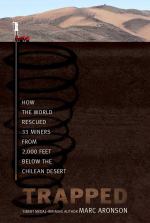
|
| Name: _________________________ | Period: ___________________ |
This test consists of 15 multiple choice questions and 5 short answer questions.
Multiple Choice Questions
1. In Chapter Two: "Of Earth and Cold," how did the formation of the Himalayan mountains influence weather patterns?
(a) It increased global temperatures.
(b) It had no effect on weather patterns.
(c) It acted as an air rudder, shaping winds and weather.
(d) It caused frequent volcanic activity.
2. In Chapter One: "August 5-6," how does the chapter describe the initial response to the incident from those in charge?
(a) Indifferent and unaware of the situation.
(b) Swift and organized.
(c) Fearful and panicked.
(d) Urgent and well-coordinated.
3. In Chapter Four: August 5–8: “Murderers,” what is the significance of the El Teniente experts, Andre Sougarret and René Aguilar?
(a) They are trained doctors providing medical care.
(b) They bring specialized knowledge of underground mining.
(c) They are experienced journalists reporting on the situation.
(d) They are relatives of the trapped miners.
4. In Chapter Six: August 10-21: “Drilling Blind,” what do the miners resort to during extreme hunger and desperation in similar situations in history?
(a) Chewing leather belts and shoes.
(b) Feeding on grass and mud.
(c) Eating the bark off wooden posts.
(d) Consuming frozen human flesh.
5. In Chapter Five: August 8–10: “Hope,” how does the chapter describe hope's role among the trapped miners?
(a) It is a vital force that keeps them going.
(b) It is a burden they must carry.
(c) It is something they have lost.
(d) It is a distant dream.
6. In Chapter One: "August 5-6," when Villegas reports the unusual events to his bosses, how do they initially react?
(a) They evacuate the entire mine.
(b) They dismiss his concerns and instruct him to return to the mine.
(c) They call for emergency assistance.
(d) They take immediate action to investigate.
7. In Chapter Two: "Of Earth and Cold," what geological event occurred around 40 million years ago?
(a) Continental collision.
(b) Earthquake.
(c) Volcanic eruption.
(d) Meteor impact.
8. In Chapter Six: August 10-21: “Drilling Blind,” what is the primary challenge faced by Kelvin Brown when drilling to reach the miners?
(a) Inaccurate maps and maps that have not been updated.
(b) A lack of drilling equipment.
(c) Resistance from the miners.
(d) A lack of drilling expertise.
9. In Chapter Five: August 8–10: “Hope,” who oversees both the rescue efforts and the emotional needs of the community at the mine site?
(a) Bishop Caspar Quintana.
(b) Minister Golborne.
(c) Luis Urzúa.
(d) President Piñera.
10. In Chapter One: "August 5-6," what is the first alarming event that Raul Villegas experiences while driving in the mine?
(a) A blinding flash of light.
(b) A strange crack.
(c) A loud explosion.
(d) A sudden temperature drop.
11. In Chapter One: "August 5-6," how does Villegas describe the dust and sound he witnesses in the mine?
(a) Like a raging volcano and a dynamite explosion.
(b) Like a gentle breeze and soft whispers.
(c) Like a gentle rain and a distant drumbeat.
(d) Like a foggy day and distant thunder.
12. In Chapter Two: "Of Earth and Cold," how did the cooling effect from the Himalayas potentially relate to the formation of ice caps at the poles?
(a) The cooling effect prevented ice caps from forming.
(b) The cooling effect likely contributed to ice cap formation.
(c) It is unrelated to ice cap formation.
(d) Ice caps were formed due to volcanic activity.
13. What effect did the Andes Mountains have on the climate along the Pacific coast of South America?
(a) They led to tropical conditions.
(b) They created extremely dry conditions.
(c) They had no impact on the climate.
(d) They caused heavy rainfall.
14. In Chapter Three: "The Men of Hephaistos," in Copiapó, what significant event occurs in 2010 that brings about a noticeable change in the town?
(a) A volcanic eruption.
(b) A gold rush.
(c) A long period of rainfall.
(d) A major earthquake.
15. In Chapter Four: August 5–8: “Murderers,” what strategy does Luis Urzúa suggest to ensure fairness in food distribution among the miners?
(a) Rationing based on age and seniority.
(b) First come, first served basis.
(c) Leaving food to be consumed at individual discretion.
(d) Sharing equally and eating together.
Short Answer Questions
1. In Chapter Six: August 10-21: “Drilling Blind,” why does Kelvin Brown feel pressure to continue drilling even when he knows it might not succeed?
2. In Chapter Three: "The Men of Hephaistos," why was bronze considered a sacred metal during ancient times?
3. In Chapter Four: August 5–8: “Murderers,” what is the main focus of concern among the miners and their families?
4. In Chapter Five: August 8–10: “Hope,” who promises that the statue of the Virgin of Candelaria will remain at the mine site during the rescue?
5. In Chapter Two: "Of Earth and Cold," what is unique about the Atacama Desert?
|
This section contains 836 words (approx. 3 pages at 300 words per page) |

|




